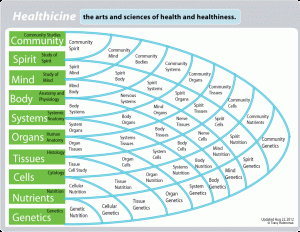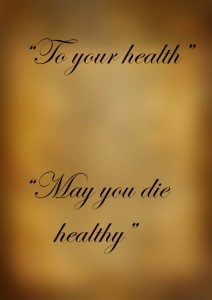The Healthicine Creed
Health is wide and deep.
Health is a noun. A healthiness is a measurable component of health.
Health is a verb. Healthing is making someone healthier.
Health encompasses all of life’s processes.
Health is whole. Health is slow and steady.
Health is honest and true.
An illness is a hole in your health.
Every illness has a cause.
Every illness is caused by imbalance.
Disease can attack from the environment.
Disease can arise from unhealthiness.
Chronic diseases have chronic causes.
Symptomicines facilitate chronic disease.
Causal cures stop the progression of a disease.
External illnesses are cured by addressing or removing causes.
Internal illnesses are cured by raising healthiness.
Every illness has internal an external components.
Healing defends against disease and repairs damage.
Healing cures aid recovery and promote healing.
Healthicines improve healthiness.
Every disease can be cured.
Health is the best preventative.
Health is the best cure, the only true cure.
The goals of healthicine are to understand, create, and improve healthiness.
Healthy foods, actions, and communications move us towards healthiness.
Healthy people are moving towards healthiness.
Everyone has a right to life, liberty, and the pursuit of healthiness.
Healthicine: The Arts and Sciences of Health and Healthiness.
A person’s health is their current life status, including physical status of body, mind, spirit, and community as well as the status of their physical, mental, spiritual and community processes. It includes ongoing nutritional statuses, exercise and resting statuses, growth and reproductive statuses, of body, mind, spirit and community.
Health is a rich and complex, interrelated, interdependent, hierarchical web of life extending from the past into the future.

The hierarchy of healthicine diagram illustrates this complexity.
Each layer of the hierarchy, from genetics and nutrients through cells, tissues, organs, bodily systems, body, minds, spirits and communities is founded on components of from prior layers.
Each layer contains many individual wholes, each of which is more than the sum of their component parts. Every component, in every layer interacts with other components in that layer and in other layers, contributing to overall healthiness.
The sciences of biology, and the practices of medicine study and have given names to most of the primary layers and many of the secondary layers of this hierarchy.
Healthicine is the arts and sciences of health and healthiness.
Health consists of the many living things, processes, and interactions that are life. Health is deep and wide, rich and complex. The complexity of health arises from the complexities of genetics, nutrients, cells, tissues, organs, bodily systems, body, minds, spirits, and communities and also the complexity of all of their interrelationships and interactions. Individuals in communities interact and reproduce, entering the hierarchy again with the new genetics of their progeny. Health benefits from richness, complexity, from time, and from freedoms. Health is not simple.
Health is a noun: health status. Health is also a verb: to improve health.
Health encompasses all of the physical aspects and all of the activities and processes of life. A healthiness is a specific, measurable aspect of health. No-one can be perfectly healthy, because the many interacting wholes, and many interacting processes of life must maintain active balance, not perfection. Healthiness can always be improved, but it can never be optimized. Optimization’s focus on specific components leads to imbalances and unhealthiness. Strong attempts to optimize health increase risk of unhealthiness and disease. Health is improved by actions that strengthen the ability to maintain balance and continually move forward, into the future, in the face of stress. Health has physical, mental, spiritual and community components. Community healthinesses exists in each individual – each member of the community, and also in the community as a whole.
Life processes begin with growth and reproduction, which require sensing and reacting to environment, exercising choices and deciding, choosing to cooperate and communicate with other life processes inside and outside of the self. The self is a whole, in the environment.
 Health is whole. Illness is hole in your health. Wellness is the absence of illness.
Health is whole. Illness is hole in your health. Wellness is the absence of illness.
Stress illnesses arrive from external sources, when a person or a community is attacked and damaged by environmental sources.
Unhealthiness illnesses arise when healthiness drops so low that illness surfaces.
Sometimes healthiness drops, allowing a stress illness to take opportunistic advantage and attack successfully – whereas it was not able to attack that person in a healthier state.
Illness can strike, or creep. Illnesses that creep are more likely to be caused by unhealthiness. Illnesses that strike are more likely to come from external sources. However, an illness that creeps often reaches a crisis point, when it strikes. Health is slow, and often not powerful enough to be of much value when an illness strikes – emergency treatments are often required. Health, and improvement in health is needed afterwards to repair and recover from the damage.
Illness should not be confused with signs or symptoms, which might indicate illness, healing, healthiness or more. An illness should not be confused with deficiencies, disabilities, aging, or other natural attributes of a healthy person. Illness is active. It has active causes.
Health is not the opposite of illness. Illness can eat away at your healthiness. Because of the interconnectedness and interdependencies of health, an illness in one area can affect health in many areas. Wellness is the absence of illness. As you become more well, your illness fades.
Health is whole. It includes the current status, and also the potential for improvement. Health is the best preventative. Health is the best treatment, for non-critical illness. Health is the most effective cure, perhaps the only true cure. Healing grows from healthiness.
Healthy foods, actions and communications move us, and our communities, towards healthiness. Actions that prevent illness, truly prevent illness – are actions that improve healthiness. Actions that cure illness, truly cure illness – are actions that improve healthiness. Healthy actions, that improve healthiness, are also the best way to fight aging. Aging is a natural process of life, a natural gradual deterioration of faculties, that proceeds more slowly when we are healthier, and faster when we have less healthiness and when we are ill.
The best treatments for illness are health, the improvement of healthiness. When a treatment works, it improves your health. A treatment that does not improve your healthiness is flawed, risky, and may need to be undone. Treating symptoms does not improve healthiness, although it can assist the body’s natural healing and healthy processes, by providing rest and relief. But, if the aim is not to cure, the aim is off target, too low.
Every disease, every illness can be cured, by definition. Of course it is not possible to cure every case, it is not possible to cure every patient, but every disease can be cured as long as it and the causes are detected in time. If it cannot be cured, it is not a disease.
Illnesses caused by external stress are cured by removing the stressor, or by improving health such that the body can handle the stress. Both are healthy actions. Unhealthiness illnesses are internal illnesses, that can only be cured by raising healthiness. Is there any other way, any other path than health, to cures? Once an illness is cured, healing works to repair damaged areas.
The common cold is easily cured by the body’s healthy immune system. A healthier immune system, and a healthier body, cures a cold faster, a less healthy body needs more time. Searching for a medicine to cure a cold ‘faster’ can be foolhardy and risky. Treating the symptoms of a cold can help the body to cure faster, but it can just as easily enable activities that do not help the cure.
It’s easy to confuse remission and re-emergence with cure and recurrence. Remission is remission of symptoms, not remission of illness. If the illness is not cured, remission of symptoms can only lead to their re-emergence as the illness progresses. Cures stop and remove the illness, by addressing causes. Recurrence is a new illness, of the same type – and does not invalidate the cure. You get a cold, your body cures the cold, you might get a new cold at a later date. You might even have two different colds, at the same time.
It is important to separate the concept of cure from the concept of healing. Cures are attained by removing or inactivating causes, stopping the progression of an illness. Healing is repairing the damage done by an illness. The healing process is active before the illness arrives, when the illness is present, and after the illness has been cured.
Healing comes from health. Healing is an active, ongoing, ever-present process in every living entity arising through the healthy, natural processes of growth and aging. Damage occurs continually from the environment and from normal life processes. Healing repairs the damage. When we are ill, damage increases and can even accelerate. Healing cannot keep pace. Once the illness passes, healing is the process of recovery. Sometimes, full recovery is possible – sometimes not.

We all want to live healthy lives.
We will all die. That is an inevitable fact of
every individual’s life.
No one wants to die from a lingering, debilitating illness.
We all want to die healthy.
to your health, may you die healthy, tracy
ps.
Since originally publishing this blog post, I have spent many hours refining the concept of the Healthicine Creed, preparing a small book to present the creed in detail. Today, I updated this version of the creed to match the version in the draft book. Oct 7, 2015.
Tracy is the author of two books about healthicine:


